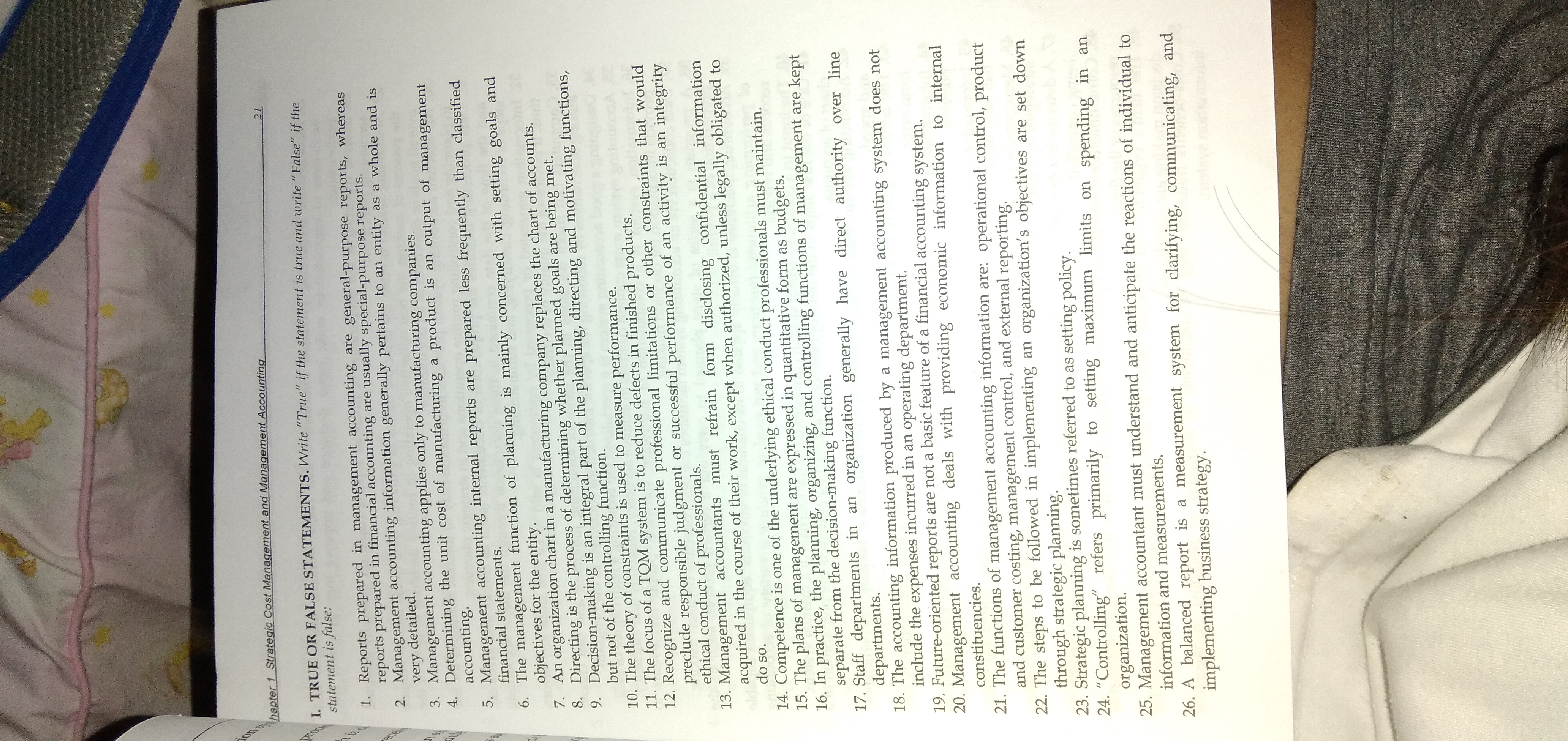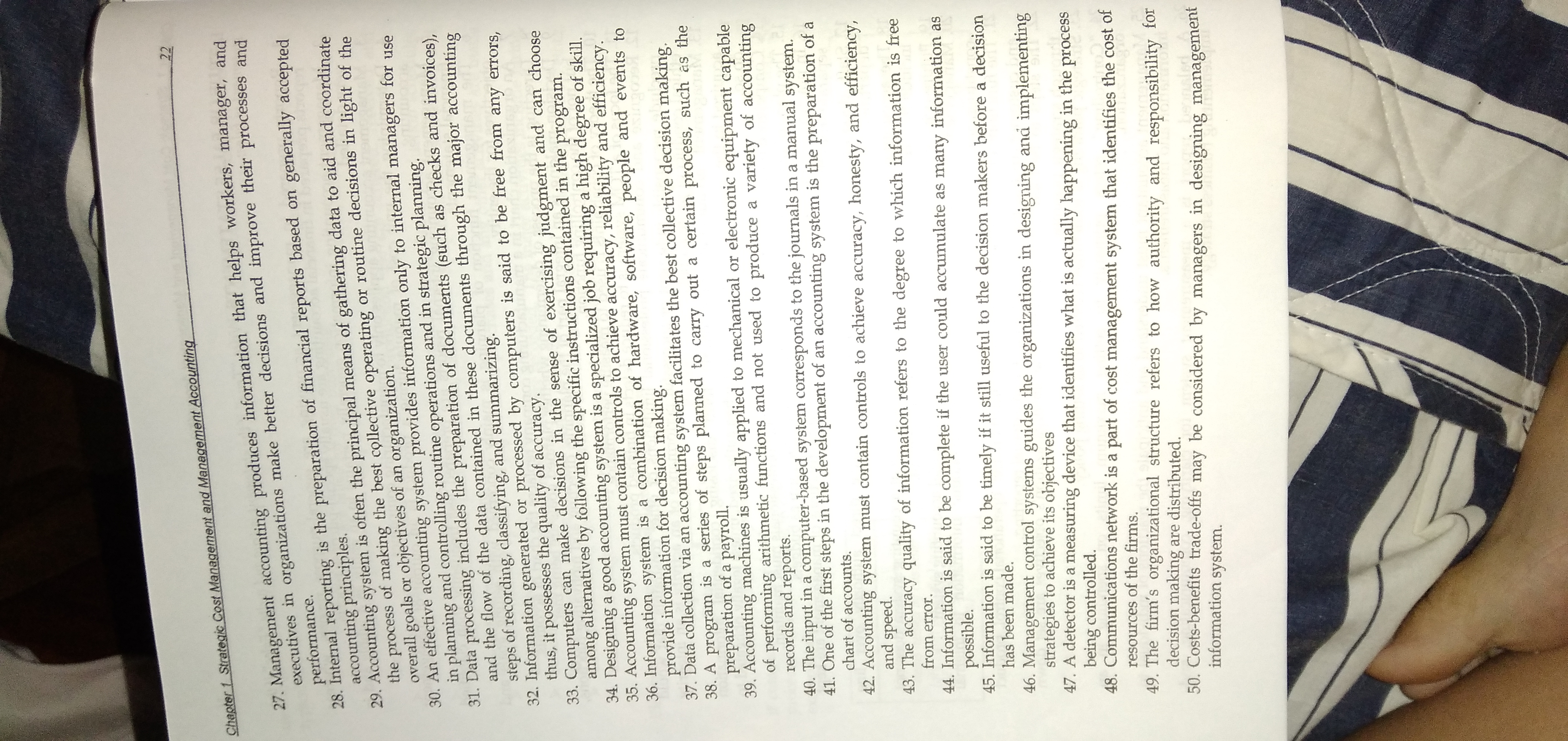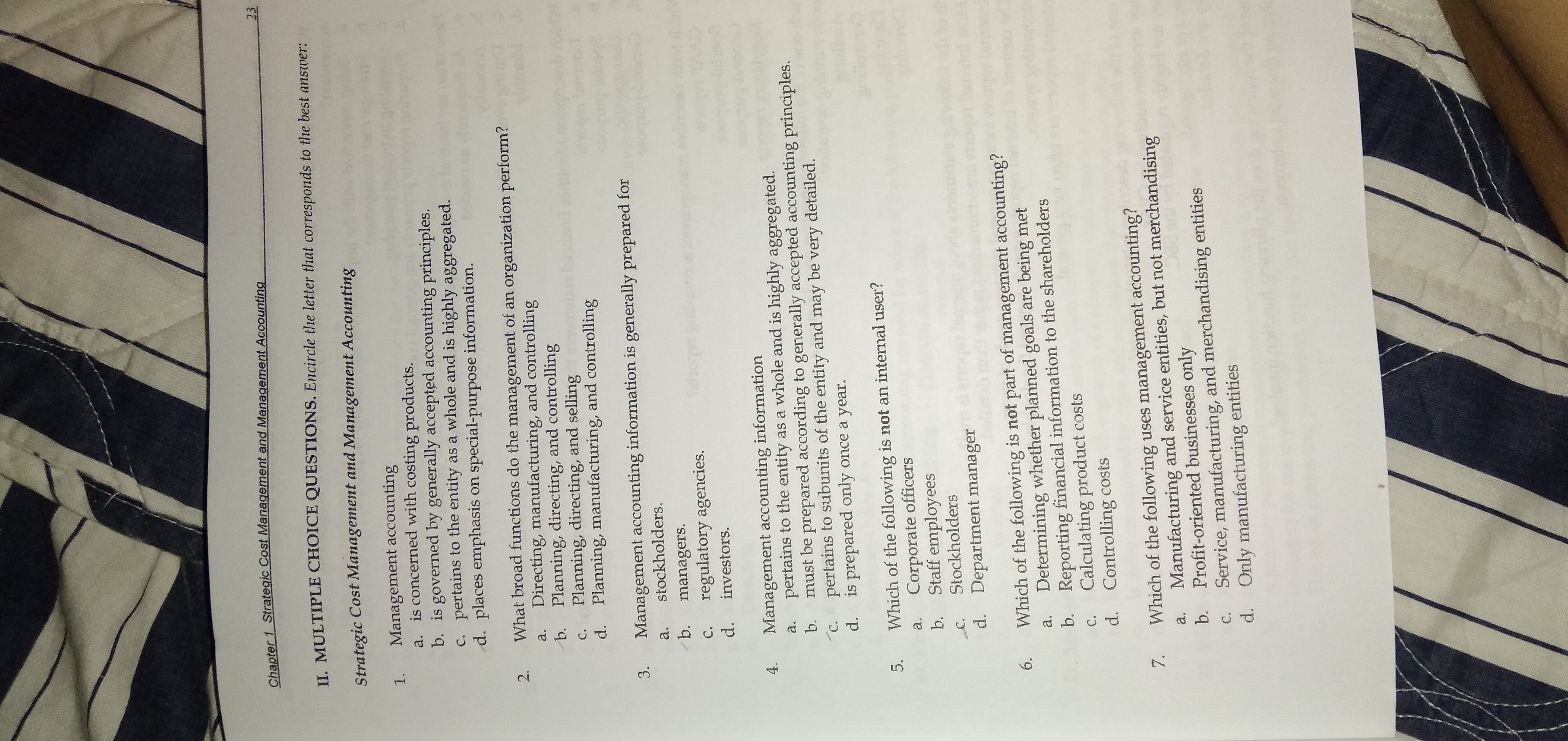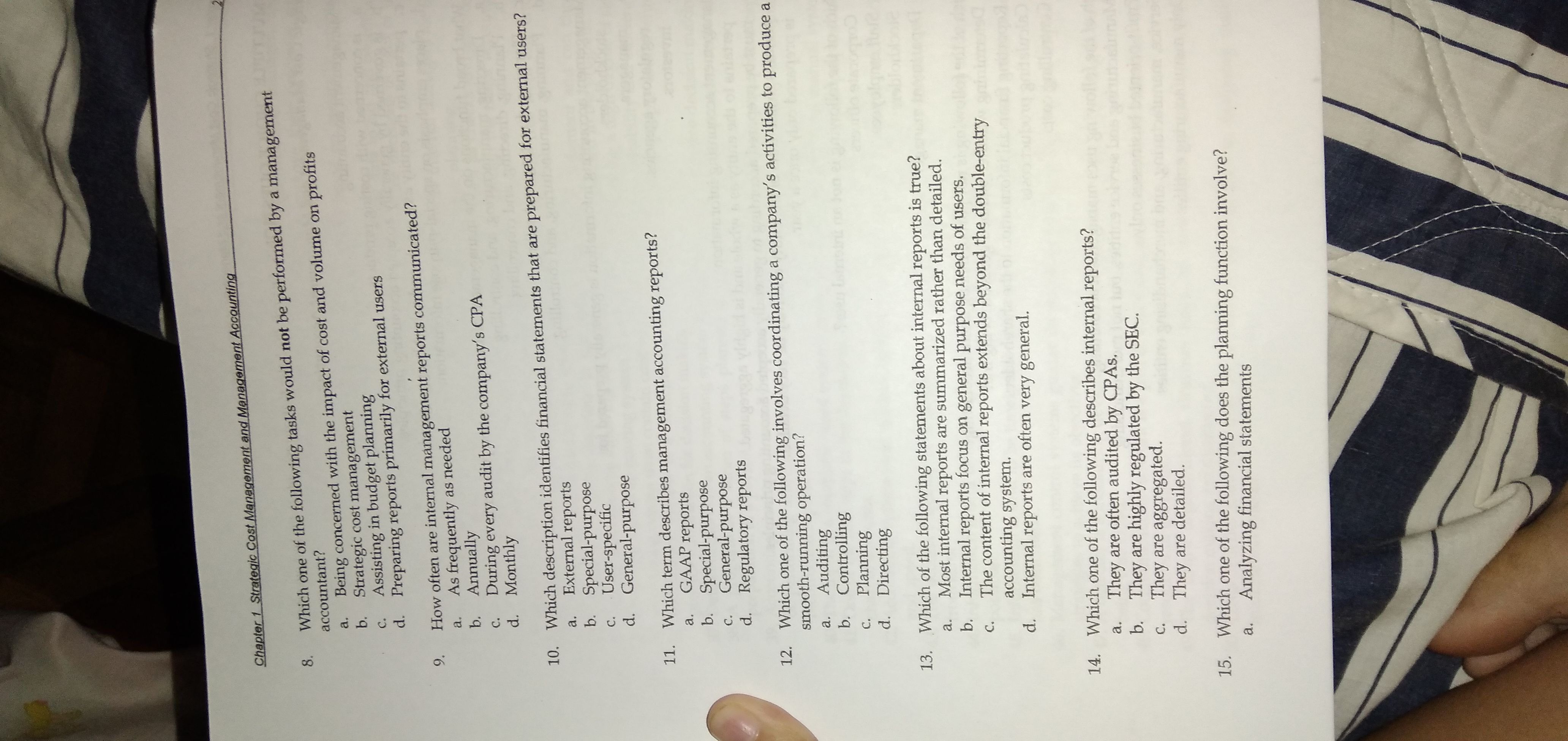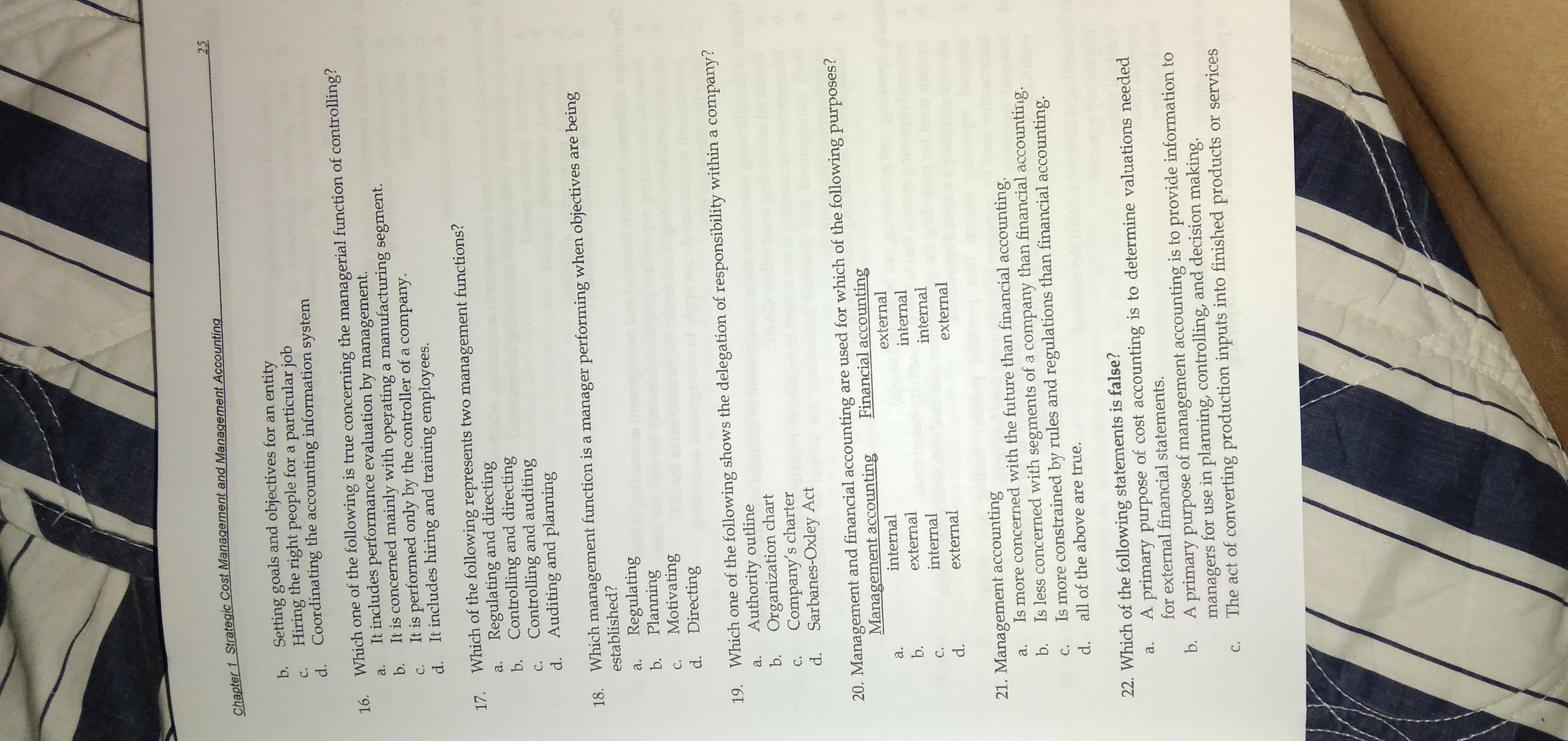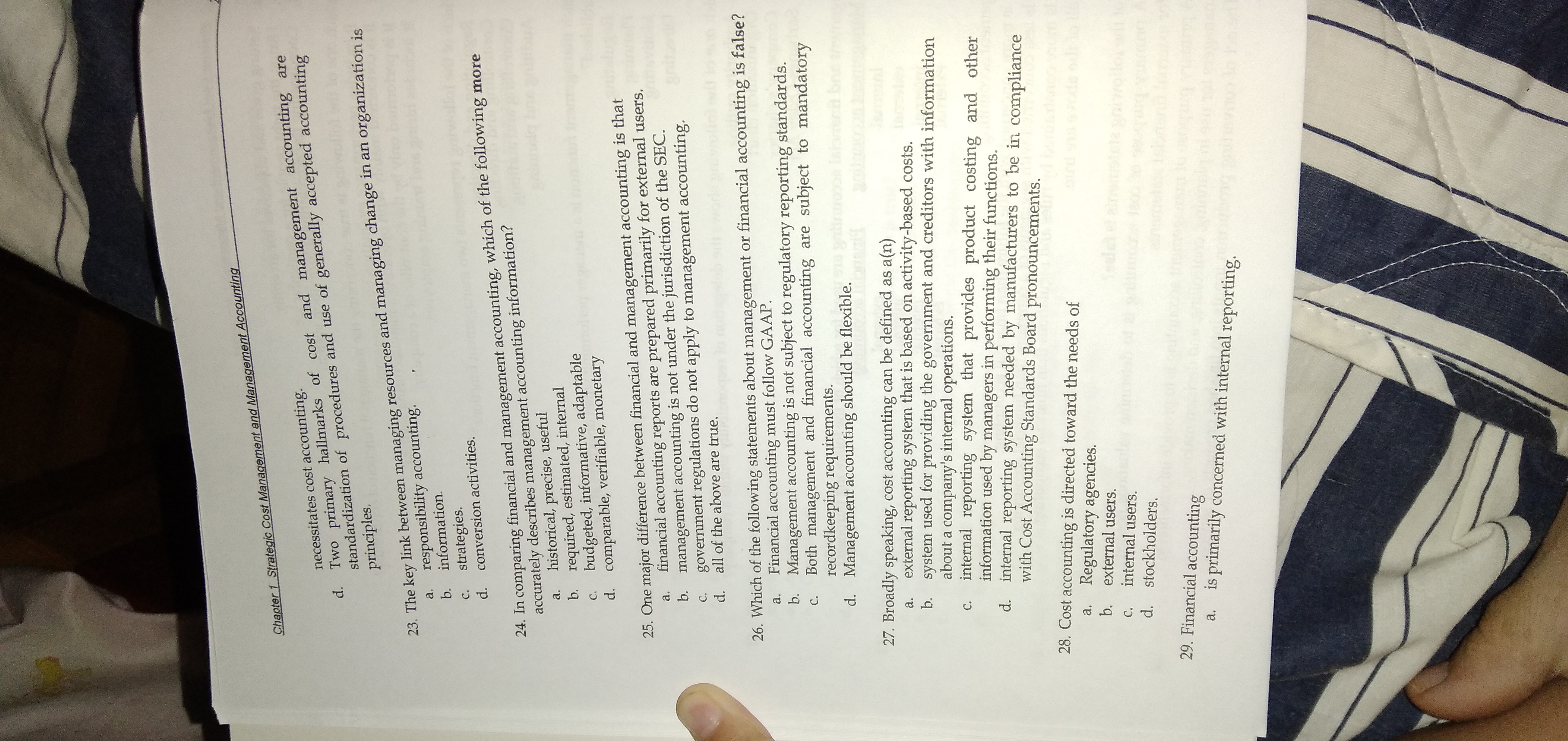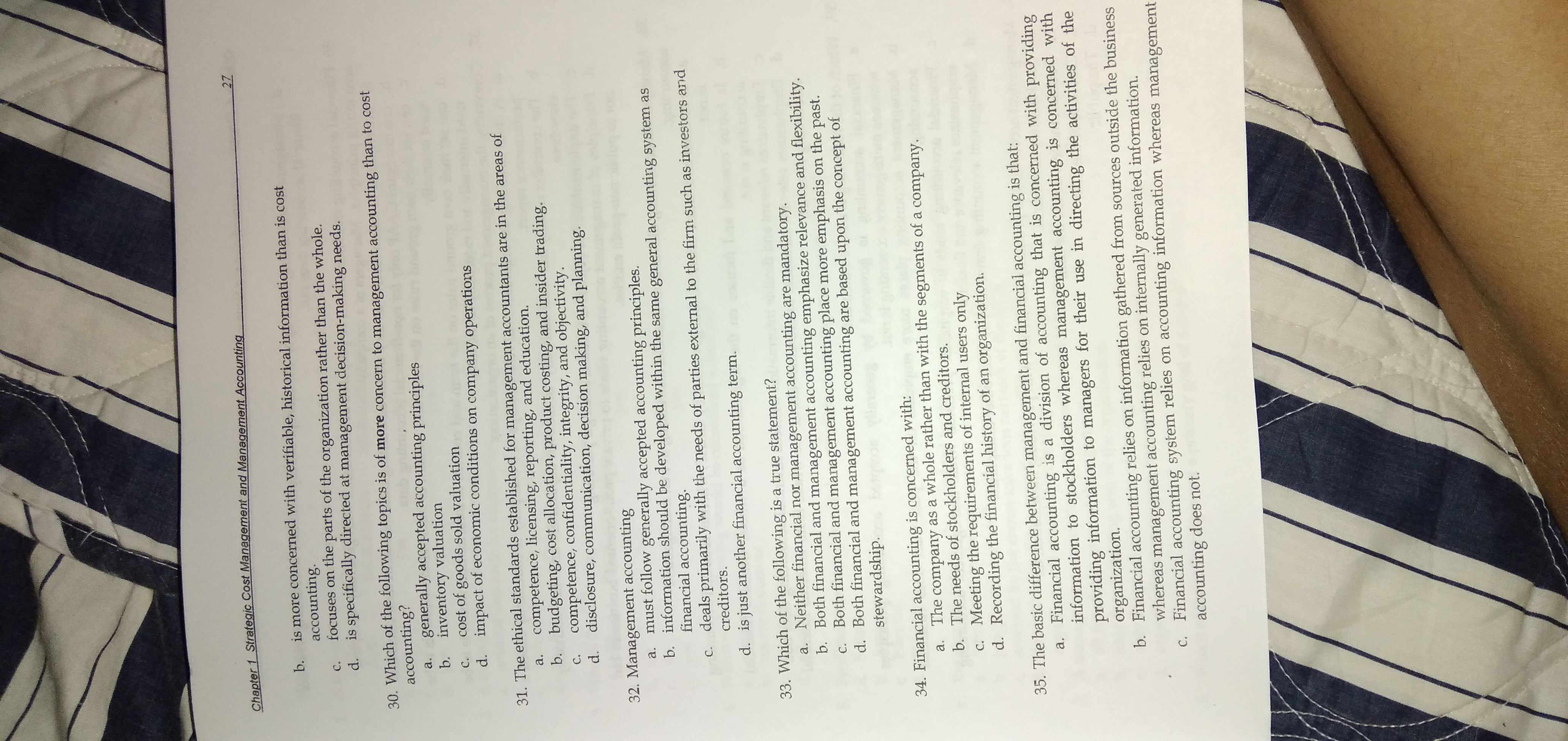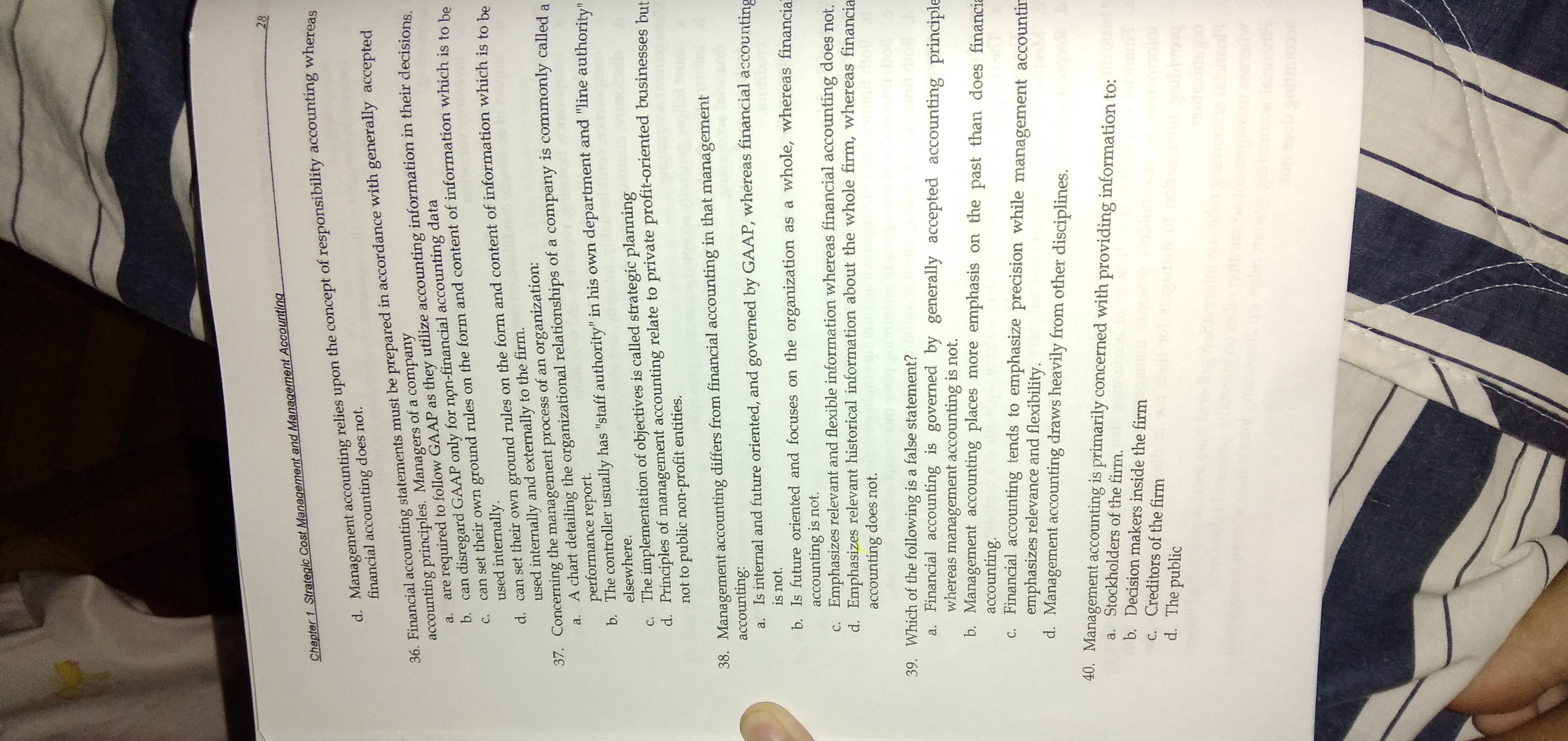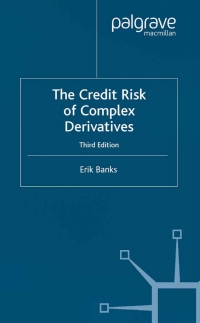Pls answer this from the book Strategic Cost Management by Payongayong,Roque and Oliveros
?
hapter 1 Strategic Cost Management and Management Accounting 21 I. TRUE OR FALSE STATEMENTS. Write "True" if the statement is true and write "False" if the statement is false: 1. Reports prepared in management accounting are general-purpose reports, whereas reports prepared in financial accounting are usually special-purpose reports. 2. Management accounting information generally pertains to an entity as a whole and is very detailed. 3. Management accounting applies only to manufacturing companies. 4. Determining the unit cost of manufacturing a product is an output of management accounting. 5. Management accounting internal reports are prepared less frequently than classified financial statements. 6. The management function of planning is mainly concerned with setting goals and objectives for the entity. 7. An organization chart in a manufacturing company replaces the chart of accounts. 8. Directing is the process of determining whether planned goals are being met. 9. Decision-making is an integral part of the planning, directing and motivating functions, but not of the controlling function. 10. The theory of constraints is used to measure performance. 11. The focus of a TOM system is to reduce defects in finished products. 12. Recognize and communicate professional limitations or other constraints that would preclude responsible judgment or successful performance of an activity is an integrity ethical conduct of professionals. 13. Management accountants must refrain form disclosing confidential information acquired in the course of their work, except when authorized, unless legally obligated to do so. 14. Competence is one of the underlying ethical conduct professionals must maintain. 15. The plans of management are expressed in quantitative form as budgets. 16. In practice, the planning, organizing, and controlling functions of management are kept separate from the decision-making function. 17. Staff departments in an organization generally have direct authority over line departments. 18. The accounting information produced by a management accounting system does not include the expenses incurred in an operating department. 19. Future-oriented reports are not a basic feature of a financial accounting system. 20. Management accounting deals with providing economic information to internal constituencies. 21. The functions of management accounting information are: operational control, product and customer costing, management control, and external reporting. 22. The steps to be followed in implementing an organization's objectives are set down through strategic planning. 23. Strategic planning is sometimes referred to as setting policy. 24. "Controlling" refers primarily to setting maximum limits on spending in an organization. 25. Management accountant must understand and anticipate the reactions of individual to information and measurements. 26. A balanced report is a measurement system for clarifying, communicating, and implementing business strategy.22 Chapter 1 Strategic Cost Management and Management Accounting 27. Management accounting produces information that helps workers, manager, and executives in organizations make better decisions and improve their processes and performance. 28. Internal reporting is the preparation of financial reports based on generally accepted accounting principles. 29. Accounting system is often the principal means of gathering data to aid and coordinate the process of making the best collective operating or routine decisions in light of the overall goals or objectives of an organization. 30. An effective accounting system provides information only to internal managers for use in planning and controlling routine operations and in strategic planning. 31. Data processing includes the preparation of documents (such as checks and invoices), and the flow of the data contained in these documents through the major accounting steps of recording, classifying, and summarizing. 32. Information generated or processed by computers is said to be free from any errors, thus, it possesses the quality of accuracy. 33. Computers can make decisions in the sense of exercising judgment and can choose among alternatives by following the specific instructions contained in the program. 34. Designing a good accounting system is a specialized job requiring a high degree of skill. 35. Accounting system must contain controls to achieve accuracy, reliability and efficiency. 36. Information system is a combination of hardware, software, people and events to provide information for decision making. 37. Data collection via an accounting system facilitates the best collective decision making. 38. A program is a series of steps planned to carry out a certain process, such as the preparation of a payroll. 39. Accounting machines is usually applied to mechanical or electronic equipment capable of performing arithmetic functions and not used to produce a variety of accounting records and reports. 10. The input in a computer-based system corresponds to the journals in a manual system. 41. One of the first steps in the development of an accounting system is the preparation of a chart of accounts. 42. Accounting system must contain controls to achieve accuracy, honesty, and efficiency, and speed. 13. The accuracy quality of information refers to the degree to which information is free from error. 44. Information is said to be complete if the user could accumulate as many information as possible. 45. Information is said to be timely if it still useful to the decision makers before a decision has been made. 46. Management control systems guides the organizations in designing and implementing strategies to achieve its objectives being controlled. 47. A detector is a measuring device that identifies what is actually happening in the process 48. Communications network is a part of cost management system that identifies the cost of resources of the firms. 49. The firm's organizational structure refers to how authority and responsibility for decision making are distributed. 50. Costs-benefits trade-offs may be considered by managers in designing management information system.Chapter 1 Strategic Cost Management and Management Accounting 23 II. MULTIPLE CHOICE QUESTIONS. Encircle the letter that corresponds to the best answer: Strategic Cost Management and Management Accounting 1. Management accounting a. is concerned with costing products. b. is governed by generally accepted accounting principles. c. pertains to the entity as a whole and is highly aggregated. d. places emphasis on special-purpose information. 2 . What broad functions do the management of an organization perform? a . Directing, manufacturing, and controlling b. Planning, directing, and controlling C. Planning, directing, and selling eab roby d. Planning, manufacturing, and controlling 3. Management accounting information is generally prepared for a. stockholders. b. managers. C . regulatory agencies. d. investors. 4 Management accounting information a. pertains to the entity as a whole and is highly aggregated. b. must be prepared according to generally accepted accounting principles. C. pertains to subunits of the entity and may be very detailed. . is prepared only once a year. 5 . Which of the following is not an internal user? a . Corporate officers b. Staff employees C . Stockholders d. Department manager 6. Which of the following is not part of management accounting? a . Determining whether planned goals are being met b. Reporting financial information to the shareholders c. Calculating product costs d. Controlling costs 7. Which of the following uses management accounting? a. Manufacturing and service entities, but not merchandising b. Profit-oriented businesses only C . Service, manufacturing, and merchandising entities d. Only manufacturing entitiesChapter 1 Strategic Cost Management and Management Accounting Which one of the following tasks would not be performed by a management 8. accountant? Being concerned with the impact of cost and volume on profits a. b. Strategic cost management C. Assisting in budget planning d. Preparing reports primarily for external users 9. How often are internal management reports communicated? a. As frequently as needed b. Annually C. During every audit by the company's CPA d. Monthly 10. Which description identifies financial statements that are prepared for external users? a. External reports b. Special-purpose C. User-specific d. General-purpose 11. Which term describes management accounting reports? a. GAAP reports b. Special-purpose C. General-purpose . Regulatory reports 12. Which one of the following involves coordinating a company's activities to produce a smooth-running operation? a . Auditing b . Controlling C. Planning d. Directing 13. Which of the following statements about internal reports is true? a. Most internal reports are summarized rather than detailed. b. Internal reports focus on general purpose needs of users. C . The content of internal reports extends beyond the double-entry accounting system. d. Internal reports are often very general. 14. Which one of the following describes internal reports? They are often audited by CPAs. b. They are highly regulated by the SEC. C. They are aggregated. d. They are detailed. 15. Which one of the following does the planning function involve? a. Analyzing financial statementsChapter 1 Strategic Cost Management and Management Accounting 25 b. Setting goals and objectives for an entity C. Hiring the right people for a particular job d. Coordinating the accounting information system 16. Which one of the following is true concerning the managerial function of controlling? a. It includes performance evaluation by management. b. It is concerned mainly with operating a manufacturing segment. C . It is performed only by the controller of a company. d. It includes hiring and training employees. 17. Which of the following represents two management functions? a. Regulating and directing b . Controlling and directing C. Controlling and auditing d. Auditing and planning 18. Which management function is a manager performing when objectives are being established? a . Regulating b . Planning C . Motivating d. Directing 19. Which one of the following shows the delegation of responsibility within a company? a . Authority outline b . Organization chart C . Company's charter d. Sarbanes-Oxley Act 20. Management and financial accounting are used for which of the following purposes? Management accounting Financial accounting internal external P b. external internal internal internal external external 21. Management accounting a. Is more concerned with the future than financial accounting. b. Is less concerned with segments of a company than financial accounting. . Is more constrained by rules and regulations than financial accounting. d. all of the above are true. 22. Which of the following statements is false? a. A primary purpose of cost accounting is to determine valuations needed for external financial statements. . A primary purpose of management accounting is to provide information to managers for use in planning, controlling, and decision making. c. The act of converting production inputs into finished products or servicesChapter 1 Strategic Cost Management and Management Accounting necessitates cost accounting. Two primary hallmarks of cost and management accounting are d. standardization of procedures and use of generally accepted accounting principles. 23. The key link between managing resources and managing change in an organization is a. responsibility accounting. b . information. C. strategies. d. conversion activities. 24. In comparing financial and management accounting, which of the following more accurately describes management accounting information? a. historical, precise, useful b . required, estimated, internal C. budgeted, informative, adaptable d. comparable, verifiable, monetary 25. One major difference between financial and management accounting is that a. financial accounting reports are prepared primarily for external users. b. management accounting is not under the jurisdiction of the SEC. C. government regulations do not apply to management accounting. d. all of the above are true. 26. Which of the following statements about management or financial accounting is false? a. Financial accounting must follow GAAP. b. Management accounting is not subject to regulatory reporting standards. C. Both management and financial accounting are subject to mandatory recordkeeping requirements. d. Management accounting should be flexible. and bru 27. Broadly speaking, cost accounting can be defined as a(n) a. b . external reporting system that is based on activity-based costs. system used for providing the government and creditors with information about a company's internal operations. C. internal reporting system that provides product costing and other information used by managers in performing their functions. d. internal reporting system needed by manufacturers to be in compliance with Cost Accounting Standards Board pronouncements. 28. Cost accounting is directed toward the needs of a. Regulatory agencies. b. external users. C . internal users. d. stockholders. 29. Financial accounting a. is primarily concerned with internal reporting.Chapter 1 Strategic Cost Management and Management Accounting 27 b. is more concerned with verifiable, historical information than is cost accounting. C. focuses on the parts of the organization rather than the whole. d. is specifically directed at management decision-making needs. 30. Which of the following topics is of more concern to management accounting than to cost accounting? a. generally accepted accounting principles b. inventory valuation C. cost of goods sold valuation d. impact of economic conditions on company operations 31. The ethical standards established for management accountants are in the areas of a . competence, licensing, reporting, and education. b. budgeting, cost allocation, product costing, and insider trading. C . competence, confidentiality, integrity, and objectivity. d. disclosure, communication, decision making, and planning. 32. Management accounting a. must follow generally accepted accounting principles. b . information should be developed within the same general accounting system as financial accounting. c. deals primarily with the needs of parties external to the firm such as investors and creditors. d. is just another financial accounting term. 33. Which of the following is a true statement? a. Neither financial nor management accounting are mandatory. b. Both financial and management accounting emphasize relevance and flexibility. C . Both financial and management accounting place more emphasis on the past. d. Both financial and management accounting are based upon the concept of stewardship. 34. Financial accounting is concerned with: a. The company as a whole rather than with the segments of a company. b. The needs of stockholders and creditors. c. Meeting the requirements of internal users only d. Recording the financial history of an organization. 35. The basic difference between management and financial accounting is that: a. Financial accounting is a division of accounting that is concerned with providing information to stockholders whereas management accounting is concerned with providing information to managers for their use in directing the activities of the organization. b. Financial accounting relies on information gathered from sources outside the business whereas management accounting relies on internally generated information. c. Financial accounting system relies on accounting information whereas management accounting does not.28 Chapter 1 Strategic Cost Management and Management Accounting d. Management accounting relies upon the concept of responsibility accounting whereas financial accounting does not. 36. Financial accounting statements must be prepared in accordance with generally accepted accounting principles. Managers of a company a. are required to follow GAAP as they utilize accounting information in their decisions. b. can disregard GAAP only for non-financial accounting data c. can set their own ground rules on the form and content of information which is to be used internally. d. can set their own ground rules on the form and content of information which is to be used internally and externally to the firm. 37. Concerning the management process of an organization: a. A chart detailing the organizational relationships of a company is commonly called a performance report. b. The controller usually has "staff authority" in his own department and "line authority elsewhere. c. The implementation of objectives is called strategic planning d. Principles of management accounting relate to private profit-oriented businesses but not to public non-profit entities. 38. Management accounting differs from financial accounting in that management accounting: a. Is internal and future oriented, and governed by GAAP, whereas financial accounting is not. b. Is future oriented and focuses on the organization as a whole, whereas financia accounting is not. c. Emphasizes relevant and flexible information whereas financial accounting does not. d. Emphasizes relevant historical information about the whole firm, whereas financia accounting does not. 39. Which of the following is a false statement? a. Financial accounting is governed by generally accepted accounting principle whereas management accounting is not. b. Management accounting places more emphasis on the past than does financi accounting. c. Financial accounting tends to emphasize precision while management accounti emphasizes relevance and flexibility. d. Management accounting draws heavily from other disciplines. 40. Management accounting is primarily concerned with providing information to: a. Stockholders of the firm. b. Decision makers inside the firm c. Creditors of the firm fod sanoin d. The public youbivorg
